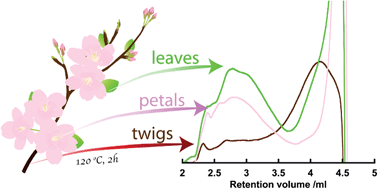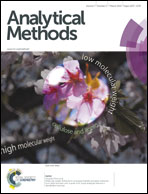Molecular weight distributions of polysaccharides and lignin extracted from plant biomass with a polar ionic liquid analysed without a derivatisation process†
Abstract
Polysaccharides and lignin, extracted from wheat bran with 1-ethyl-3-methylimidazolium methylphosphonate, were directly analysed with high-performance liquid chromatography with the aid of ionic liquid as an eluent (HPILC). Polysaccharides and lignin were clearly detected independently with the use of both a refractive index detector and UV detector. Polysaccharides with low molecular weights were obtained at 25 °C in 2 h with an extraction yield of only 4%. High molecular weight polysaccharides were extracted with a yield of 26% at 120 °C and selective extraction of high MW polysaccharides was succeeded with pretreatment at low temperature. Furthermore, a similar extraction was carried out for wood biomass. Characteristics of pine and oak were observed in the molecular weight distributions of the extracted polysaccharides and lignin. We also analysed the extracts from different parts of Prunus × yedoensis ‘Somei-yoshino’. The average molecular weight of polysaccharides from its leaves was determined to be lower than that of its twigs. The present HPILC method has potential to rapidly and easily analyse molecular weight distributions of components of plants.


 Please wait while we load your content...
Please wait while we load your content...